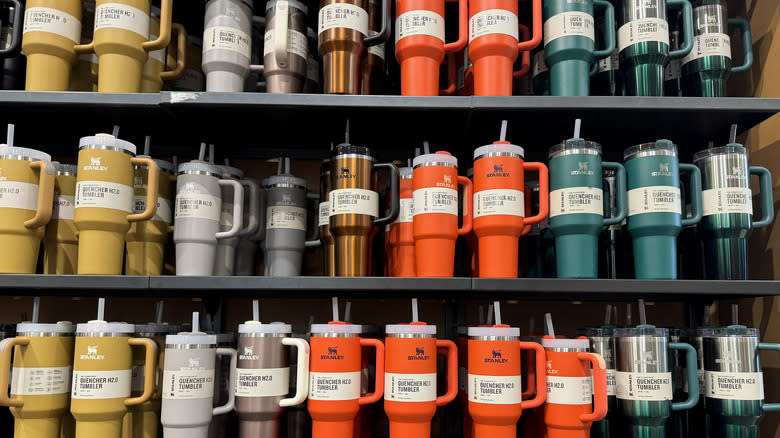How Often Do You Need To Replace Your Stanley Tumbler?

The title "Stanley Cup" means two different things to drink lovers and hockey fans — but as it turns out, they have more in common than just the iconic name. Both are made of shiny steel and can hold an impressive amount of liquid. Seriously, Stanley tumblers are the real deal. They somehow manage to fit perfectly inside cup holders while still being able to carry up to 40 ounces of beverage. To top it off, they're incredibly durable.
According to the official Stanley website, Stanley tumblers are made to last a lifetime. Unless you're strong (or really good at breaking things), you likely won't need a replacement thanks to the high-grade stainless steel, BPA-free polypropylene lids, and silicone gasket sealant (and yes, Stanley cups do contain lead, but you shouldn't care). In fact, a viral TikTok showing a woman's Stanley surviving a car fire fully intact proves just how heavy-duty these things are.
The material is also made to handle everyday wear and tear with its rust-proof metal. Now, we're not encouraging you never to clean the thing, but it's probably unlikely you'll find anything suspicious defacing the inner surface. If you do, it's most likely harmless particles that have built up. The good news is that it's super easy to remove. A non-abrasive cleaner applied with a soft brush, sponge, or cloth will do the trick. You can also use a specific stainless-steel cleaner if the particles are tough, but avoid using metal brushes as they can scratch.
Read more: The Most Useless Cooking Utensils, According To Chefs
Extra Steps To Increase Its Lifespan

Getting the most out of the lifetime guarantee is all about intentional care. If the tumbler is damaged due to alteration or accident, warranties no longer apply. Out of precaution, you should use gentler cleansing techniques; Stanley specifically advises against using harsh chemicals like bleach. Simply soaking the cup in warm water, baking soda, vinegar, and lemon juice can remove just about any small imperfection. Even if the cup looks clean, rinse it after every use and deep clean it a few times a week to avoid mold and bacteria growth.
You should also avoid placing Stanley cups in a freezer, microwave, or dishwasher. It's no secret that powerful microwave heat is notorious for damaging products, and the freezer is a similar story. Liquids expand when they freeze, so the cold temperatures can actually change the Stanley's shape over time. Subsequently, the freezer can compromise the thermal and sealing abilities of insulated tumblers. The no dishwasher rule is definitely a downer but necessary to expand longevity. Stanley suggests that many of its products are dishwasher safe (check the bottom of your tumbler) and can be placed on the top rack. However, the brand also notes that hand washing is the safest bet if you're trying to maintain the finish and paint for as long as possible. As long as you frequently treat your Stanley tumbler with a little TLC, rest assured that it'll be your emotional support water bottle for a long time.
Read the original article on Mashed

